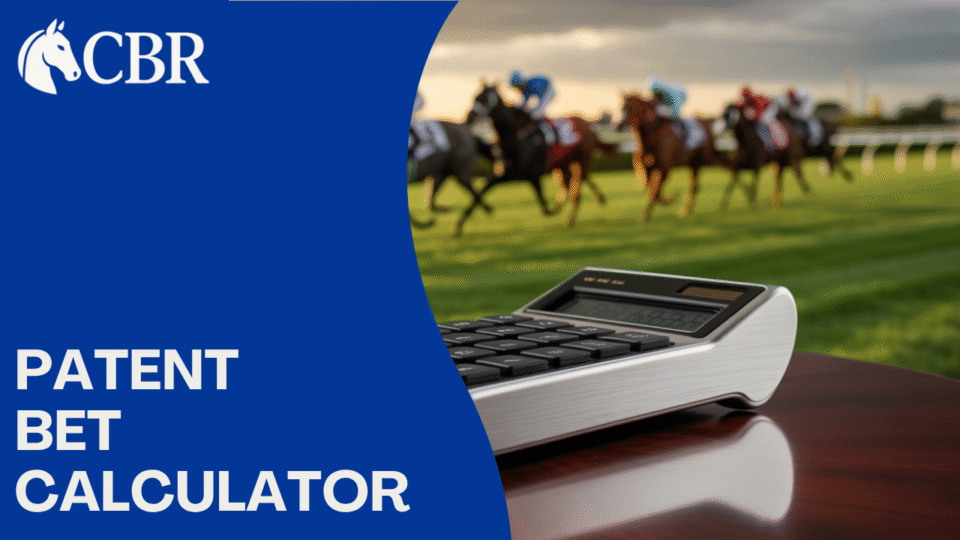A Patent Bet Calculator helps you quickly determine your potential returns, profit, and total stake when placing a Patent bet, which involves three selections across seven bets. Using such a calculator simplifies complex calculations by instantly breaking down singles, doubles, and trebles, so you know the precise outcome of your bet. This clarity means you spend less time on maths and more time making informed decisions.
You can enter your stake, odds, and even apply specific rules like Rule 4 deductions or each-way options, which influence your total return. Because the calculator handles all the permutations, it removes the guesswork, especially when selections can win, place, or be void. Therefore, it becomes an essential tool if you want to understand the exact impact of each selection on your overall bet.
The calculator is useful not only for horse or greyhound racing but for any betting categories where Patent bets are available. Since your stake multiplies across seven bets, knowing precise returns helps you manage your spending and expectations. As a result, it offers a straightforward way to track your multiple bets and optimise your betting strategy efficiently.
Contents
What Is a Patent Bet Calculator?
A Patent Bet Calculator helps you quickly determine the cost, potential returns, and profit of a patent bet involving three selections. It allows you to evaluate various outcomes from your wager by breaking down the complex components of this bet type.
This tool simplifies calculations that would otherwise be time-consuming and lets you understand exactly how much each part of your bet could pay based on different odds and stakes.
How Does the Patent Bet Calculator Work?
The calculator takes your input of odds and stake per bet and breaks down the patent bet into its seven sub-bets: three singles, three doubles, and one treble. It then computes the individual returns for each based on the odds provided.
Because your stake is multiplied by seven (one stake per sub-bet), the calculator also totals your overall cost automatically. This means you can see your total outlay without having to manually multiply stakes.
The tool then calculates potential profit and total returns according to how many selections win and their respective odds. This helps you understand exactly how profitable the bet could be under different scenarios.
Using a patent bet calculator ensures precision and saves you from manual errors, which is important because patent bets have multiple combinations that influence your final payout.
Key Features of a Patent Bet Calculator
A patent bet calculator typically offers these key functionalities:
- Stake Input: Enter the amount wagered on each sub-bet, which it multiplies by seven for your total stake.
- Odds Entry: Input the odds for your three selections individually to calculate potential outcomes.
- Return Breakdown: Detailed display of returns for singles, doubles, and trebles, showing how each contributes to your total payout.
- Profit Calculation: Shows your net profit after subtracting the total stake from returns.
- Scenario Simulation: Ability to test different winning combinations, enabling you to see profits based on one, two, or all three winners.
- User-Friendly Interface: Designed for quick calculations, ideal for sports bettors who want to make informed decisions without complex math.
These features deliver clarity on how your patent bet performs, allowing you to adjust your stakes or selections strategically before placing bets on various bookmaker websites.
How Do You Place a Patent Bet?
Placing a Patent bet requires selecting three outcomes across different events and understanding how each bet type covers your selections. You will need to manage several smaller bets within the total stake and know how these interact to produce returns depending on your results.
Understanding Three Selections
To place a Patent bet, you must select three separate outcomes in any sports betting market. These can be from the same sport or different events, but they must be independent for the bet to qualify. Each of these selections forms the foundation of your Patent bet.
The total stake you place will be multiplied by seven because the Patent bet consists of seven smaller bets. This means if you stake £1 per bet, your total stake is £7. This placement method ensures that your bet covers multiple combinations, increasing your chance of earning a return if even one selection wins.
Singles, Doubles, and Treble in Patent Bets
A Patent bet includes seven bets spread across singles, doubles, and a treble based on your three selections. These are:
| Bet Type | Description | Number of Bets |
|---|---|---|
| Singles | Individual bets on each selection | 3 |
| Doubles | Bets on every pair of selections | 3 |
| Treble | Bet on all three selections combined | 1 |
The singles pay out if any single selection wins, which means you start generating returns without needing multiple winners. Doubles require two selections to succeed, offering higher payouts. The treble needs all three selections to win but usually delivers the largest return.
When you enter the stake on a betting site, this total stake covers all seven bets. This setup allows you to benefit in multiple ways, such as securing some return if only one selection wins or greater profits if two or all three are successful.
How Do You Use a Patent Bet Calculator Effectively?
Using a Patent bet calculator involves entering accurate stake amounts and odds to reflect your intended bet across multiple selections. Adjustments for rule 4 and dead heat situations ensure your total stake and potential returns are precise despite changes in race conditions or tied results.
Entering Your Stake and Odds
First, input the unit stake you want to place on each individual bet within the Patent combination. Since a Patent involves seven bets (3 singles, 3 doubles, 1 treble), the total stake will be the unit stake multiplied by seven. This figure shows your overall outlay on the bet.
Next, enter the odds for each of your three selections. The calculator will process these odds to generate potential returns on singles, doubles, and the treble. Some calculators allow you to use decimal or fractional odds, so ensure you select the format that matches your betting site.
The patent bet calculator will then display your total potential returns and the profit you would make if all or some of the selections win. This helps you assess whether your possible winnings justify the total stake involved before placing your bet.
Applying Rule 4 and Dead Heat Adjustments
If one or more of your selections is subject to a Rule 4 deduction due to a withdrawal or reduced field size, you should input the relevant Rule 4 percentage into the calculator. The calculator will reduce your potential winnings accordingly, ensuring your expected return reflects the adjusted odds.
In the case of a dead heat, where two or more selections tie, the calculator adjusts your returns by dividing your stake on the tied selection proportionally. This ensures the total payout equals the prize shared between tied competitors, allowing for accurate profit calculations despite the tie.
By using these adjustments, the patent bet calculator provides a true picture of your total stake outlay and the precise returns you can expect. This keeps your betting calculations aligned with real race outcomes and changes.
What Are the Advantages of Patent Betting?
Patent betting offers a flexible way to build multiple bets from just three selections. It allows you to gain returns from various outcomes while managing your stake through a set structure. This versatility makes it appealing compared to other bets like the Lucky 15 or Yankee.
Potential Returns and Profit Scenarios
A Patent bet combines seven bets: three singles, three doubles, and one treble. This means you can earn returns even if just one selection wins, unlike bets that require multiple wins to pay out. Your profit potential increases because multiple bet types are covered in one wager.
The payout depends heavily on the odds of each selection. If all three selections win, you receive combined returns from every successful bet line, which generates a higher total profit than placing singles individually. However, you must remember that your stake applies to all seven bets, which increases your initial outlay.
If only one selection succeeds, you still receive a return on the single bet. This feature allows a Patent bet to provide some protection on losing selections but typically requires at least two winners to cover the total stake with profit.
Comparing Patent Bets to Other Bet Types
Compared to a Lucky 15 or Yankee, a Patent bet contains fewer bets but includes singles, which means you can see some returns when only one pick wins. Lucky 15s and Yankees comprise 15 and 11 bets respectively, so they require more stake and are better suited for larger budgets.
The inclusion of singles means Patent betting is more affordable than those formats yet offers more chances of getting a partial return than an accumulator. Unlike a treble, which needs all selections to win, the Patent bet provides better flexibility because profits come from multiple bet types.
Since Patent bets cover all combinations of three selections, you have an overall simpler stake compared to other bets with more lines. This can help you track outcomes more easily, reducing confusion about profit and losses on some websites.
Which Alternative Bets Should You Consider?
When selecting alternative bets, it’s vital to focus on options that offer broader coverage or varied payouts based on multiple selections. Understanding the differences helps you balance potential returns against complexity and stake size effectively.
Lucky 15 and Yankee Bets Explained
A Lucky 15 bet consists of 15 bets on four selections. It includes 4 singles, 6 doubles, 4 trebles, and 1 four-fold accumulator. This means you get more chances for a return, as even a single winning selection pays out due to the singles included.
Compared to the Lucky 15, a Yankee covers 11 bets but excludes singles. It only includes 6 doubles, 4 trebles, and 1 four-fold accumulator. This raises the required stake but increases the potential profit if multiple selections win.
Both bets are multiples that spread your stake across several combinations, allowing you to profit from different winning permutations. The bonus with Lucky 15 is its singles, providing returns when fewer picks succeed.
How Does Patent Betting Compare to Multiples?
A Patent bet covers seven bets on three selections: 3 singles, 3 doubles, and 1 treble. This structure guarantees some return if at least one selection wins because each selection is backed individually.
Multiples like the Yankee or Lucky 15 include more bets and selections but lack the single bets offered in a Patent. As a result, patents tend to be simpler and require less stake than larger multiples, while still offering coverage across different combinations.
The key difference is that patents use three selections and some singles, making them less complex and more affordable than systems like the Lucky 15 or Yankee, which require higher stakes for more bets but deliver greater payout possibilities if multiple selections win.
Conclusion
A Patent Bet Calculator helps you manage the complexity of multiple bets placed on three selections. It calculates your total stake, potential returns, and profit accurately, which means you can make informed decisions without manual errors.
Using this calculator allows you to quickly adjust odds formats, include each-way bets, and factor in Rule 4 deductions. This flexibility ensures the results reflect real betting conditions, so your calculations remain relevant and precise.
By simplifying multiple bet combinations, the calculator saves you valuable time and effort. You can focus on your strategy while trusting that the payout results and stakes have been correctly computed.
If you want to improve your betting approach with Patent bets, using a reliable calculator is essential. It is a straightforward tool that helps you evaluate scenarios and optimise your stakes accordingly.







